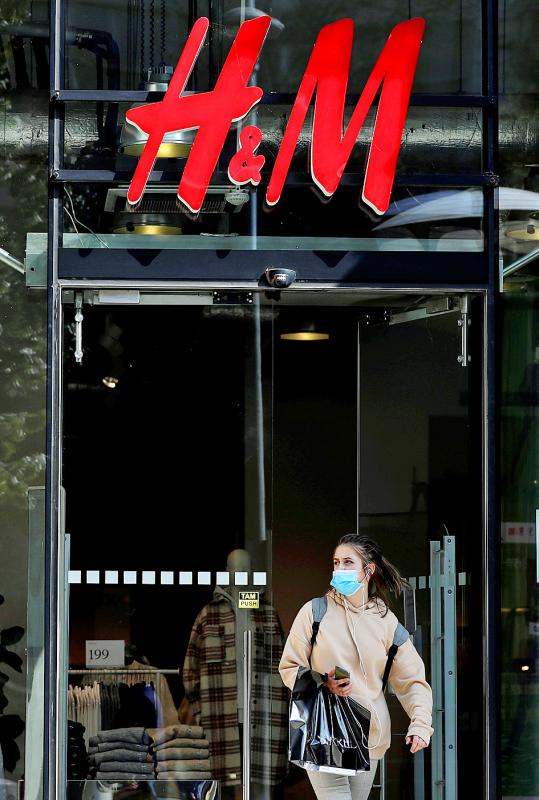Swedish clothing giant Hennes & Mauritz AB (H&M) on Tuesday said that it was ending its relationship with a Chinese yarn producer over accusations of “forced labor” involving ethnic and religious minorities from China’s Xinjiang region.
The fashion retailer specified that it did not work with any garment factories in the region and that it would no longer source cotton from Xinjiang, which is China’s largest cotton-growing area.
A report by the Australian Strategic Policy Institute think tank, published in March, pointed to H&M as one of the beneficiaries of a forced labor transfer program through their relationship with the dyed yarn producer Huafu Fashion Co’s (華孚時尚) factory in Anhui Province.

Photo: Reuters
However, H&M said in a statement that it had never had a relationship with the factory in Anhui, nor Huafu’s operations in Xinjiang.
H&M did concede that it has an “indirect business relationship with one mill” in Shangyu in Zhejiang Province, belonging to Huafu.
“While there are no indications for forced labor in the Shangyu mill, we have decided to, until we get more clarity around allegations of forced labor, phase out our indirect business relationship with Huafu Fashion Co, regardless of unit and province, within the next 12 months,” H&M said.
The company also said that it had conducted “an inquiry at all the garment manufacturing factories we work with in China aiming to ensure that they are not employing workers ... through what is reported on as labor transfer programs or employment schemes where forced labor is an increased risk.”
International pressure is building on the Chinese Communist Party over its actions in the resource-rich Xinjiang region, and the EU on Monday pressed China to let its independent observers into Xinjiang, binding human rights to future trade and investment deals with Beijing.
Rights groups say that more than 1 million Uighurs languish in political re-education camps, which Beijing describes as vocational training centers where education is given to lift the population out of poverty and to chisel away at Islamic radicalism.
China says that criticism of its handling of Xinjiang is politically motivated, and based on lies about what happens in the vast facilities it has built.
US Customs and Border Protection on Monday said it would bar a raft of Chinese products from Xinjiang over fears that they were made using forced labor.
China on Tuesday slammed the US move as “bullying” and dismissed accusations of forced labor as “a complete fabrication.”

GROWING OWINGS: While Luxembourg and China swapped the top three spots, the US continued to be the largest exposure for Taiwan for the 41st consecutive quarter The US remained the largest debtor nation to Taiwan’s banking sector for the 41st consecutive quarter at the end of September, after local banks’ exposure to the US market rose more than 2 percent from three months earlier, the central bank said. Exposure to the US increased to US$198.896 billion, up US$4.026 billion, or 2.07 percent, from US$194.87 billion in the previous quarter, data released by the central bank showed on Friday. Of the increase, about US$1.4 billion came from banks’ investments in securitized products and interbank loans in the US, while another US$2.6 billion stemmed from trust assets, including mutual funds,

AI TALENT: No financial details were released about the deal, in which top Groq executives, including its CEO, would join Nvidia to help advance the technology Nvidia Corp has agreed to a licensing deal with artificial intelligence (AI) start-up Groq, furthering its investments in companies connected to the AI boom and gaining the right to add a new type of technology to its products. The world’s largest publicly traded company has paid for the right to use Groq’s technology and is to integrate its chip design into future products. Some of the start-up’s executives are leaving to join Nvidia to help with that effort, the companies said. Groq would continue as an independent company with a new chief executive, it said on Wednesday in a post on its Web

Even as the US is embarked on a bitter rivalry with China over the deployment of artificial intelligence (AI), Chinese technology is quietly making inroads into the US market. Despite considerable geopolitical tensions, Chinese open-source AI models are winning over a growing number of programmers and companies in the US. These are different from the closed generative AI models that have become household names — ChatGPT-maker OpenAI or Google’s Gemini — whose inner workings are fiercely protected. In contrast, “open” models offered by many Chinese rivals, from Alibaba (阿里巴巴) to DeepSeek (深度求索), allow programmers to customize parts of the software to suit their

JOINT EFFORTS: MediaTek would partner with Denso to develop custom chips to support the car-part specialist company’s driver-assist systems in an expanding market MediaTek Inc (聯發科), the world’s largest mobile phone chip designer, yesterday said it is working closely with Japan’s Denso Corp to build a custom automotive system-on-chip (SoC) solution tailored for advanced driver-assistance systems and cockpit systems, adding another customer to its new application-specific IC (ASIC) business. This effort merges Denso’s automotive-grade safety expertise and deep vehicle integration with MediaTek’s technologies cultivated through the development of Media- Tek’s Dimensity AX, leveraging efficient, high-performance SoCs and artificial intelligence (AI) capabilities to offer a scalable, production-ready platform for next-generation driver assistance, the company said in a statement yesterday. “Through this collaboration, we are bringing two